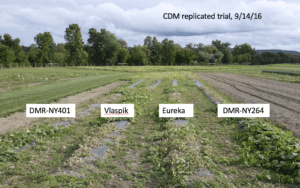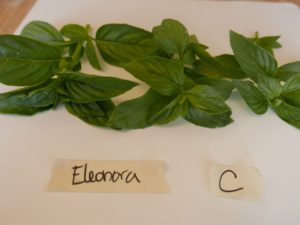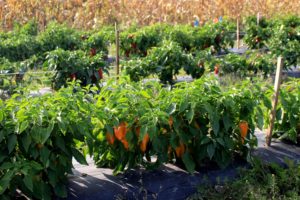What Can Variety Trialing Do for Your Vegetable Farm?
Put those glowing seed catalog descriptions to the test and find varieties that are the best fit for your own farming environment.
A variety trial entails growing different varieties of a crop alongside each other in order to directly compare their performance across any number of characteristics. It can be highly controlled and scientific or very informal. Conducting a variety trial on your farm is a simple idea that can produce long-lasting benefits to your farm enterprise.
Why do a variety trial?
Each year new varieties crop up in your favorite seed catalogs — maybe your old standby variety is no longer offered, or you have been dissatisfied with it and are looking for alternatives. Perhaps your farmer’s market customers or chefs are asking for a crop or crop type you haven’t grown before. Catalog descriptions can give relevant information — for example, disease resistance attributes, days to maturity and beautiful photos, but they don’t tell the whole story. Much of these catalog descriptions might not reflect the conditions on your own farm, and here lies the main reason that it might be worth your while to conduct a variety trial on your farm: identifying what varieties perform best in your specific farming system and environment.
In addition, you might be looking for specific quality traits that are hard to glean from the catalog. For example, rainbow carrots might be really popular at your market stand, but you haven’t been satisfied with the variety you have been growing. Perhaps you want to find out what varieties have the best flavor, or which store the best for your winter sales. Or perhaps you want a variety with strong tops that won’t snap off when you are bunching them. Any of these traits could be the basis for a great on-farm trial, and you know best what traits are most important for your own farm.
Third, as our weather becomes more extreme and unpredictable, you might want to evaluate what varieties you will be able to count on when the weather gets weird. Although you can’t control the weather during your variety trial, testing out which varieties perform best in stress from drought, flooding, cold snaps — whatever the season throws at you — could help your cropping systems be more resilient in future years.
How to do a variety trial?
First, you need to select what crop(s) you want to trial. Crop planning can be a time of lofty goals for the season ahead, but it’s important to be realistic about your capacity and prioritize what to focus your efforts on. So, a good approach is to think about the biggest crop challenges or frustrations you have had in past seasons and focus your trial efforts where they will have the biggest pay off for you.
Once you have picked the crops you will trial, you also want to figure out exactly what your goals are for the trial, and what you want to evaluate. Do you want to find a slicing tomato that won’t crack when grown in the field, or a cilantro variety that won’t bolt as fast in hot weather? Think about what you will need to do and when, all the way from seed to harvest in order to get the information from the trial that you need.
Picking your varieties
- “Check” varieties
These are varieties that you already know are likely to perform a certain way — including the common “workhorse” varieties that you or other growers in your region count on. If your trial is focused on resistance to disease, that means including varieties that are likely susceptible as well as those that are resistant. This allows you to better draw contrasts between your varieties.
- Open pollinated vs. Hybrid
In many vegetable crops, older traditional varieties tend to be open pollinated (OP), while new varieties are either hybrids or open pollinated. If you are considering turning this into a breeding project down the line, selecting open-pollinated versus hybrid varieties will affect your choice of potential breeding material. More on that in future issues!
Designing your trial
In general, when conducting a variety trial, you want each variety to get the same exact “treatment” so that all differences you observe are due to the variety itself. A few common strategies can help you do this, and get the most out of your trial that you can.
- Replication and Randomization
It’s a good idea to do at least one replication to get a sense for how many differences between the reps you observe. Randomizing the order of variety plots within a rep is another way to minimize environmental effects. Also try to orient plots to minimize the effect of variation in your field (wet pockets, rocky spots).
- Border rows
A well-known source of variation in a crop field is “edge effect,” when environmental conditions are substantially different for the outermost rows, which can fudge your trial results. A good way to avoid this is to plant border rows surrounding your trial that you don’t plan to evaluate.
- Make a map
To make sure you don’t lose track of what’s what, it’s a good idea to overdo it when it comes to documenting your trial layout. You should label your plots in the field itself (most trials are “blind” to minimize bias, which means assigning numbers to each variety rather than writing names on the stakes).
Evaluating your trial

Example of a downy mildew resistance trial in cucumbers. Sometimes the results are obvious! Courtesy of Mazourek Lab
The most important thing in evaluating an on-farm trial is to make sure you have a reliable method to get the information you want, while being realistic about your ability to spend time on the trial.
- Keep good records
Keeping good records of the trial such as seed source, seeding or planting date, days to emergence, maturity and/or harvest etc. will are useful no matter what trait you are evaluating. If you just want to evaluate yield, you can record yields whether they are weekly fruit harvests or a bulk root harvest. If you are looking for disease resistance, you probably want to use a scale for rating disease severity, and also collect yield data.
- You’re the boss
There’s no need to go overboard and take data you don’t really need. Write down some notes, flag plots that you like at different stages of growth, whatever you think will be useful to your future self.
Stay tuned: More on Selection and On-Farm Plant Breeding in the next issue.
Kristen Loria is a Masters’ candidate in the Plant Breeding and Genetics section at Cornell University. Her own research focuses on trialing and breeding vegetable varieties for organic production systems, under the USDA NIFA-funded Northern Organic Vegetable Improvement Collaborative (Grant #: 2018-51300-28430). She is excited to be a SFQ contributor and to help grow and support a more independent, adaptive seed system for small farms. Please reach out by email: kal52@cornell.edu
References and More Resources:
The Grower’s Guide to Conducting On-Farm Variety Trials. Organic Seed Alliance. 2018.
Trials and Selection Webinar. Organic Seed Alliance. 2017.
Variety Trial Planning Worksheet. Organic Seed Alliance.
Trial Evaluation Worksheet. Organic Seed Alliance.
Resource Spotlight:
The Organic Seed Alliance advances ethical seed solutions to meet food and farming needs in a changing world. Through their research farm and extensive outreach and collaborative work, they educate growers, conduct plant breeding projects and advocate for stronger regional seed systems. Their website is a wealth of resources for all things related to conducting variety trials, on-farm plant breeding and growing seed crops, so be sure to take a look if you are looking for further information and inspiration.



